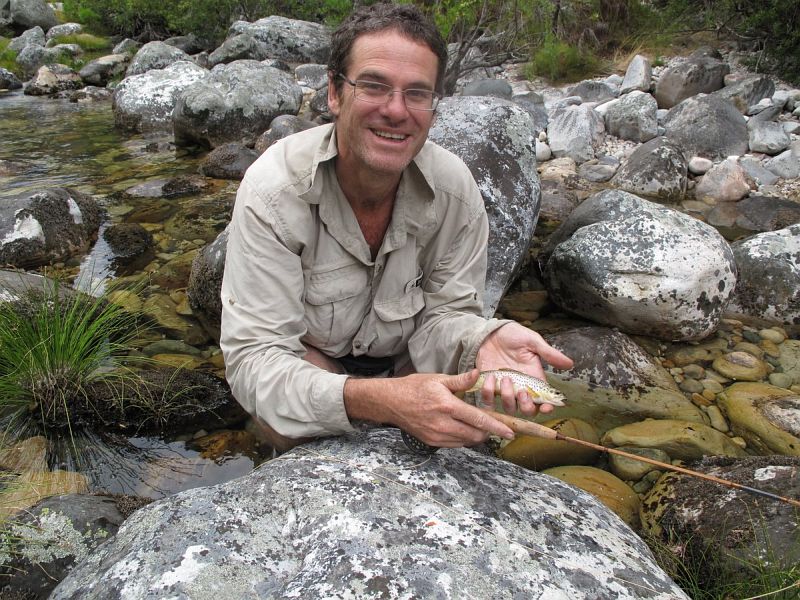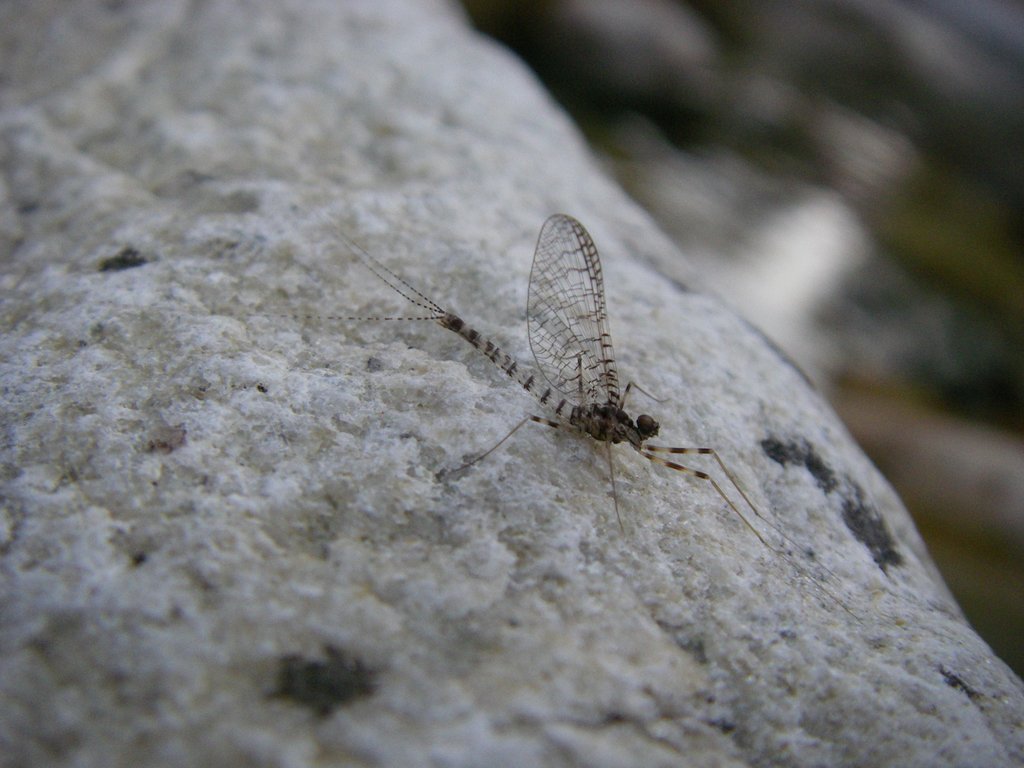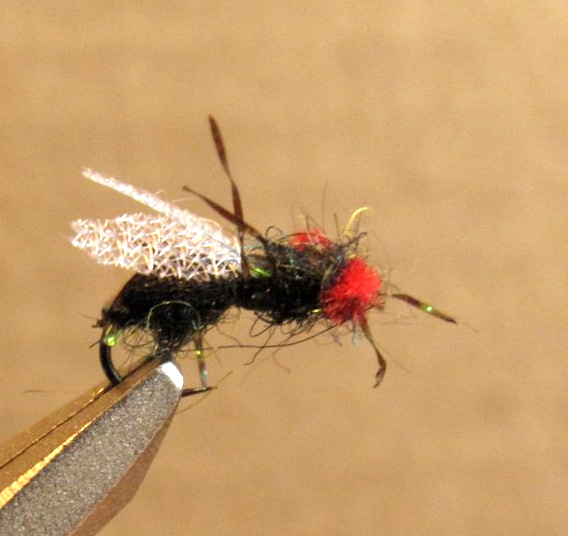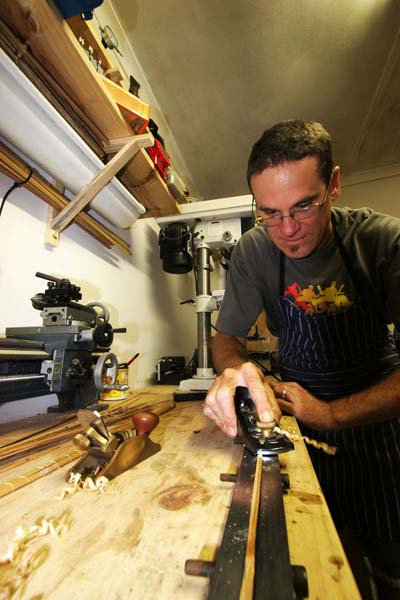SOME FAVOURITE STREAM PATTERNS OF BAMBOO ROD MAKER STEVE DUGMORE
Text and photographs of flies by Steve Dugmore. Other photos Tom Sutcliffe.

Introduction
If I had to choose only six flies to carry on a stream they would probably be, in no particular order, a Parachute Adams, a RAB or Para-RAB, an ant, a Spundun Mayfly, an Elk Hair Caddis and a Pheasant Tail Nymph.
These flies are well-known, so I have chosen six other that I carry in my box as add-ons.
Hot glue extended body mayfly.
This dry fly has probably consistently enticed more big fish for me than any other dry fly. I came up with it after too many frustrating episodes watching large fish jump out of the water to take those pale grey, size 16 mayflies that dance and dip over the surface of the water. All other mayfly patterns I have tried get refused. On one occasion I managed to catch one of the actual mayflies and had a close look at it.

What struck me was the 'fleshiness' of the body but, more so, its translucency. With this in mind I set about trying to create a translucent and fleshy extended body. After trying various epoxies, silicones etc., each of which came with their own problems, I tried hot glue. I was pleasantly surprised not only that you can achieve a reasonable body shape, you get great translucency and the added bonus that hot glue floats. CDC was an obvious choice for the wings.

Strangely, this fly is not that successful when there is no hatch on. But when fish are feeding selectively on the mayfly it imitates, it really comes into its own. The only times I have seen large fish (18-20") repeatedly clear the water on our streams is when they are hunting these mayflies. I think that the fleshiness of the body makes the energy expended in hunting them worthwhile.
I also tie this fly in smaller patterns to imitate smaller mayflies
Hook: Size 16 Skalka dry fly hook or smaller for other smaller mayflies
Thread: Typically to match the colour of the fly
Tail: Microfibbets (from a cheap paintbrush) or coq de Leon fibers
Body: Hot glue over tails
Ribbing: Thread or floss
Wing: CDC and/or cock hackle tied paraloop style
Notes on tying
I sometimes tie in a single strand of copper wire to help support the hot glue body. I usually simply wind the thread up and then down the extended body for the ribbing. This is not pretty - it does not give you even turns - but it is quick and does not seem to make too much difference to the fish. For more aesthetically pleasing flies I sometimes bury a strand of ribbing in the body and wind it back afterwards.
I use the thread itself as the paraloop, simply taking a turn over the gallows and fastening down with a few overlapping turns. If the hackle is fragile and tends to break when winding then I use a separate thicker strand of thread for the paraloop.
Hot glue
I have one of the purpose made hot glue guns. They come in various sizes from hardware stores including a small ‘hobby’ one. I use the 10mm diameter glue tube for my gun, which is a larger gun.
You do need to be careful of the heat, but I don’t think it is prohibitively dangerous. After all, my son, who is aged 10, uses them in ‘design technology’ at school.
The most difficult part is separating the stringiness that results when you pull the gun away having laid down the glue. I pull the gun a short distance, let the glue cool a bit and then just snap off the glue string. I then shape quickly with a dubbing needle before the glue sets hard.
Para-loop Mayfly
This is a generic mayfly pattern which I tie in various colours and sizes. I like paraloop hackles because they give the fly bulk and visibility on the water, provide a wing impression and still sit in the water like a parachute fly.

Hook: Dry fly hook
Thread: Typically to match colour of fly
Tail: Microfibbets (from a cheap paintbrush) or coq-de-leon fibers
Body: Dubbing or stripped quill or goose biot etc.
Ribbing: Thread or crystal flash or fine copper wire or similar
Wing: CDC and/or hackle tied paraloop style
Bloubrommer (Blue bumblebee)
This is a fun fly but one that also works as a general terrestrial searching pattern. I tied it because I think everyone should have a 'fun' fly in their box. It was inspired by Vincent Marinaro's 'Game of Nods' story in his book In the Ring of the Rise. Anyone who has read the story will appreciate the front legs reaching forwards to rub against each other. I fish this fly in slower water in the surface film with a smidgen of silicone gel floatant on the fly. It gives me a kick every time I catch a fish on it.
 Hook: Dry fly hook
Hook: Dry fly hook
Thread: Black
Body: Hends No.45 Spectra dubbing over black fly foam body
'Ribbing': Single strand of pearlescent flash over top of body
Wings: Hareline 'No-fray' winging material medium dun
Legs: Black crystal flash
Thorax: Hends No.45 Spectra dubbing
Eyes: Red chenille
Flashback ‘soft hackle' nymph
This is a generic nymph pattern which I tie in various colours. I tie the legs quite long and soft, giving the fly a soft hackle quality and lots of movement. I tie them both weighted and neutral density.

Hook: Nymph hook (generally size 16 and 18)
Weighting: If weighted, 2 or 3 winds of lead in the thorax
Thread: Typically to match colour of fly
Body: Dubbing or stripped quill or goose biot etc.
'Ribbing': Thread or Crystal Flash or fine copper wire or similar
Legs: Brown Partridge soft hackle
Thorax: Dubbing
Wing case: Pearlescent tinsel
Emerald Sunken Beetle
This is a very simple pattern that is very effective. I tie them in very small sizes and fish them alone, or as a dropper to a dry, or as part of a tandem nymph rig with an indicator. I fish it mainly in riffles and pocket water. I think the tiny twinkle of flash is a great trigger. Fish tend to hook themselves on this fly.

Hook: Size 24 Varivas Ultra Midge hook or similar http://www.theafricanflyangler.co.za/index.php?page=shop.browse&category_id=218&option=com_virtuemart&Itemid=101
Thread: Black
Body: Single strand of peacock
Thorax: Simply continue the peacock herl body or add a tiny amount of Hends No.45 Spectra dubbing and tease it out for more movement
Wing: Single strand of pearlescent flash over top of body and thorax
Antenna: None or black crystal flash
Flashback Woolly Worm
This is a deadly fly. I feel guilty including it as it feels a bit like cheating to me when I use it. It is however worth carrying as a go-to fly for desperate days. If I had to choose one fly only to fish for my life this would be it. When I do fish it nowadays I fish it alone - weighted versions for when the fish are lying low and un-weighted for shallower water. I am sure it would work well behind a bead head nymph but have never tried it. The magic of this fly is you can fish it dead drift or impart movement. It therefore works in all kinds of water.

Hook: Size 16 heavy wet fly hook
Weighting: Thin lead wire wrapped full length
Tail: Red wool
Thread: Black
Body: Peacock herl or dubbing in olives, black or brown
Back: Single strand of pearlescent flash over top of body and thorax
Hackle: Preferably ginger with black centre
Ribbing: Copper wire or thread

(Steve Dugmore is an architect living in Cape Town. He is a keen an experienced fly fisher particularly on the Western Cape's streams and is a sought after maker of high quality bamboo fly rods. See http://www.freestonerods.co.za/). Steve is also a committee member of the Cape Piscatorial Society http://www.piscator.co.za /)




